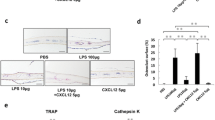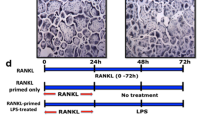Abstract
The release of tumor necrosis factor (TNF)-α from macrophages upon stimulation of lipopolysaccharide (LPS) is a major etiological factor of inflammatory bone disease and elicits the effects through TNF receptors type 1 and 2. Given the importance of TNF-α action on osteoclastic bone resorption, the role of TNF type 2 receptor (TNFR2) on bone resorption has not been elucidated well so far. The purpose of this study is to investigate the role of TNFR2 on LPS-induced inflammatory bone resorption in vivo. LPS at 10 mg/kg (Re 595) was injected subcutaneously on calvariae of wild-type (WT), TNF type 1 receptor (TNFR1)-deficient (KO), and TNFR2 KO mice, killed on day 5 after the LPS injection. The calvarial bone mineral density (BMD) was significantly decreased by LPS compared to the vehicle-injected control in WT mice, but not in TNFR1 KO mice. Interestingly, the decrease of calvarial BMD and the increase of the osteoclast number by LPS in TNFR2 KO mice seemed to be more than those in WT mice. Furthermore, the significant decrease by LPS on the BMD of tibiae, femurs, and lumber vertebrae were observed only in TNFR2 KO mice. Histomorphometric analysis of tibiae showed the significant increases of osteoclast number and surface in the LPS-injected TNFR2 KO mice, and the levels of urinary deoxypyridinoline reflected these increases of bone resorption parameters. The present data indicate that TNFR1 is critical for bone resorption at the site of LPS injection and that TNFR2 might have a protective role on the LPS-induced inflammatory bone resorption process.
Similar content being viewed by others
References
Nair SP, Meghji S, Wilson M, Reddi K, White P, Henderson B (1996) Bacterially induced bone destruction: mechanisms and misconceptions. Infect Immun 64(7):2371–2380
Montes AH, Asensi V, Alvarez V, Valle E, Ocana MG, Meana A, Carton JA, Paz J, Fierer J, Celada A (2006) The Toll-like receptor 4 (Asp299Gly) polymorphism is a risk factor for Gram-negative and haematogenous osteomyelitis. Clin Exp Immunol 143(3): 404–413
Williams RC (1990) Periodontal disease. N Engl J Med 322(6): 373–382
Itoh K, Udagawa N, Kobayashi K, Suda K, Li X, Takami M, Okahashi N, Nishihara T, Takahashi N (2003) Lipopolysaccharide promotes the survival of osteoclasts via Toll-like receptor 4, but cytokine production of osteoclasts in response to lipopolysaccharide is different from that of macrophages. J Immunol 170(7): 3688–3695
Lynn WA, Golenbock DT (1992) Lipopolysaccharide antagonists. Immunol Today 13(7):271–276
Ulevitch RJ, Tobias PS (1995) Receptor-dependent mechanisms of cell stimulation by bacterial endotoxin. Annu Rev Immunol 13:437–457
Hla T, Lee MJ, Ancellin N, Paik JH, Kluk MJ (2001) Lysophospholipids-receptor revelations. Science 294(5548):1875–1878
Pober JS, Sessa WC (2007) Evolving functions of endothelial cells in inflammation. Nat Rev Immunol 7(10):803–815
Wei S, Kitaura H, Zhou P, Ross FP, Teitelbaum SL (2005) IL-1 mediates TNF-induced osteoclastogenesis. J Clin Invest 115(2): 282–290
Kitaura H, Sands MS, Aya K, Zhou P, Hirayama T, Uthgenannt B, Wei S, Takeshita S, Novack DV, Silva MJ, Abu-Amer Y, Ross FP, Teitelbaum SL (2004) Marrow stromal cells and osteoclast precursors differentially contribute to TNF-α-induced osteoclastogenesis in vivo. J Immunol 173(8):4838–4846
Brennan FM, Foey AD, Feldmann M (2006) The importance of T cell interactions with macrophages in rheumatoid cytokine production. Curr Top Microbiol Immunol 305:177–194
Gupta S (2001) Molecular steps of tumor necrosis factor receptormediated apoptosis. Curr Mol Med 1(3):317–324
Screaton G, Xu XN (2000) T cell life and death signalling via TNFreceptor family members. Curr Opin Immunol 12(3):316–322
Feng X (2005) Regulatory roles and molecular signaling of TNF family members in osteoclasts. Gene (Amst) 350(1):1–13
Teitelbaum SL (2006) Osteoclasts; culprits in inflammatory osteolysis. Arthritis Res Ther 8(1):201
Abu-Amer Y, Ross FP, Edwards J, Teitelbaum SL (1997) Lipopolysaccharide-stimulated osteoclastogenesis is mediated by tumor necrosis factor via its P55 receptor. J Clin Invest 100(6): 1557–1565
Saito H, Kojima T, Takahashi M, Horne WC, Baron R, Amagasa T, Ohya K, Aoki K (2007) A tumor necrosis factor receptor loop peptide mimic inhibits bone destruction to the same extent as antitumor necrosis factor monoclonal antibody in murine collageninduced arthritis. Arthritis Rheum 56(4):1164–1174
Suzuki Y, Aoki K, Saito H, Umeda M, Nitta H, Baron R, Ohya K (2006) A tumor necrosis factor-α antagonist inhibits inflammatory bone resorption induced by Porphyromonas gingivalis infection in mice. J Periodont Res 41(2):81–91
Nagahama K, Aoki K, Nonaka K, Saito H, Takahashi M, Varghese BJ, Shimokawa H, Azuma M, Ohya K, Ohyama K (2004) The deficiency of immunoregulatory receptor PD-1 causes mild osteopetrosis. Bone (NY) 35(5):1059–1068
Aoki K, Didomenico E, Sims NA, Mukhopadhyay K, Neff L, Houghton A, Amling M, Levy JB, Horne WC, Baron R (1999) The tyrosine phosphatase SHP-1 is a negative regulator of osteoclastogenesis and osteoclast resorbing activity: increased resorption and osteopenia in mev/mev mutant mice. Bone (NY) 25(3): 261–267
Aoki K, Saito H, Itzstein C, Ishiguro M, Shibata T, Blanque R, Mian AH, Takahashi M, Suzuki Y, Yoshimatsu M, Yamaguchi A, Deprez P, Mollat P, Murali R, Ohya K, Horne WC, Baron R (2006) A TNF receptor loop peptide mimic blocks RANK ligand-induced signaling, bone resorption, and bone loss. J Clin Invest 116(6): 1525–1534
Luo D, Luo Y, He Y, Zhang H, Zhang R, Li X, Dobrucki WL, Sinusas AJ, Sessa WC, Min W (2006) Differential functions of tumor necrosis factor receptor 1 and 2 signaling in ischemiamediated arteriogenesis and angiogenesis. Am J Pathol 169(5): 1886–1898
Goukassian DA, Qin G, Dolan C, Murayama T, Silver M, Curry C, Eaton E, Luedemann C, Ma H, Asahara T, Zak V, Mehta S, Burg A, Thorne T, Kishore R, Losordo DW (2007) Tumor necrosis factor-α receptor p75 is required in ischemia-induced neovascularization. Circulation 115(6):752–762
Wilson MR, Goddard ME, O’Dea K P, Choudhury S, Takata M (2007) Differential roles of p55 and p75 tumor necrosis factor receptors on stretch-induced pulmonary edema in mice. Am J Physiol Lung Cell Mol Physiol 293(1):L60–L68
Higuchi Y, McTiernan CF, Frye CB, McGowan BS, Chan TO, Feldman AM (2004) Tumor necrosis factor receptors 1 and 2 differentially regulate survival, cardiac dysfunction, and remodeling in transgenic mice with tumor necrosis factor-α-induced cardiomyopathy. Circulation 109(15):1892–1897
Amar S, Van Dyke TE, Eugster HP, Schultze N, Koebel P, Bluethmann H (1995) Tumor necrosis factor (TNF)-induced cutaneous necrosis is mediated by TNF receptor 1. J Inflamm 47(4):180–189
Kondo S, Sauder DN (1997) Tumor necrosis factor (TNF) receptor type 1 (p55) is a main mediator for TNF-α-induced skin inflammation. Eur J Immunol 27(7):1713–1718
Abu-Amer Y, Abbas S, Hirayama T (2004) TNF receptor type 1 regulates RANK ligand expression by stromal cells and modulates osteoclastogenesis. J Cell Biochem 93(5):980–989
Abu-Amer Y, Erdmann J, Alexopoulou L, Kollias G, Ross FP, Teitelbaum SL (2000) Tumor necrosis factor receptors types 1 and 2 differentially regulate osteoclastogenesis. J Biol Chem 275(35): 27307–27310
Zhang YH, Heulsmann A, Tondravi MM, Mukherjee A, Abu-Amer Y (2001) Tumor necrosis factor-α (TNF) stimulates RANKL-induced osteoclastogenesis via coupling of TNF type 1 receptor and RANK signaling pathways. J Biol Chem 276(1): 563–568
Lee SY, Lee SY, Choi Y (1997) TRAF-interacting protein (TRIP): a novel component of the tumor necrosis factor receptor (TNFR)-and CD30-TRAF signaling complexes that inhibits TRAF2-mediated NF-kappaB activation. J Exp Med 185(7):1275–1285
Tartaglia LA, Ayres TM, Wong GH, Goeddel DV (1993) A novel domain within the 55 kd TNF receptor signals cell death. Cell 74(5):845–853
Rothe M, Sarma V, Dixit VM, Goeddel DV (1995) TRAF2-mediated activation of NF-kappa B by TNF receptor 2 and CD40. Science 269(5229):1424–1427
Suda K, Udagawa N, Sato N, Takami M, Itoh K, Woo JT, Takahashi N, Nagai K (2004) Suppression of osteoprotegerin expression by prostaglandin E2 is crucially involved in lipopolysaccharide-induced osteoclast formation. J Immunol 172(4):2504–2510
Maruyama K, Takada Y, Ray N, Kishimoto Y, Penninger JM, Yasuda H, Matsuo K (2006) Receptor activator of NF-kappa B ligand and osteoprotegerin regulate proinflammatory cytokine production in mice. J Immunol 177(6):3799–3805
Author information
Authors and Affiliations
Corresponding author
Additional information
Electronic supplementary material The online version of this article (doi: 10.1007/s00774-007-0834-0) contains supplementary material, which is available to authorized users.
Electronic supplementary material
About this article
Cite this article
Hussain Mian, A., Saito, H., Alles, N. et al. Lipopolysaccharide-induced bone resorption is increased in TNF type 2 receptor-deficient mice in vivo. J Bone Miner Metab 26, 469–477 (2008). https://doi.org/10.1007/s00774-007-0834-0
Received:
Accepted:
Published:
Issue Date:
DOI: https://doi.org/10.1007/s00774-007-0834-0




